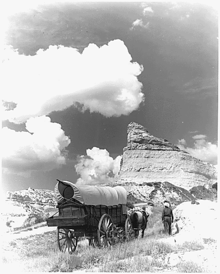- Conestoga wagon
-
The Conestoga wagon is a heavy, broad-wheeled covered wagon that was used extensively during the late 18th century and the 19th century in the United States and sometimes in Canada as well. It was large enough to transport loads up to 8 tons (7 metric tons), and was drawn by horses, mules or oxen. It was designed to resemble a boat, to help it cross rivers and streams, though it sometimes leaked unless one caulked the wagon.
Contents
History
The first known mention of a "Conestogoe waggon" was December 31, 1717 in the accounting log of James Logan after purchasing it from James Hendricks. [1] It was named after the "Conestoga River" or "Conestoga Township" in Lancaster County, Pennsylvania, and thought to have been introduced by Mennonite German settlers. [2]
In colonial times the Conestoga wagon was popular for migration southward through the Great Appalachian Valley along the Great Wagon Road. After the American Revolution it was used to open up commerce to Pittsburgh and Ohio. In 1820 rates charged were roughly one dollar per 100 pounds per 100 miles, with speeds about 15 miles (25 km) per day. The Conestoga, often in long wagon trains, was the primary overland cargo vehicle over the Appalachians until the development of the railroad. The wagon was pulled by a team of up to eight horses or up to a dozen oxen.[citation needed] For this purpose, the Conestoga horse, a special breed of medium to heavy draft horses, was developed.
The Conestoga wagon was cleverly built. Its floor curved upward to prevent the contents from tipping and shifting. The average Conestoga wagon was 18 feet long, 11 feet high, and 4 feet in width. It could carry up to 12,000 pounds of cargo. The cracks in the body of the wagon were stuffed with tar to protect them from leaking while crossing rivers. Also for protection against bad weather, stretched across the wagon was a tough, white canvas cover. The frame and suspension were made of wood, while the wheels were often iron-rimmed for greater durability. Water barrels built on the side of the wagon held water, and toolboxes held tools needed for repair on the wagon. Also, the feedbox on the back of the wagon was used to feed the horses. The Conestoga wagon was used for many types of travel including passage to California during the California Gold Rush.
The term "Conestoga wagon" refers specifically to this type of vehicle; it is not a generic term for "covered wagon". The wagons used in the westward expansion of the United States were, for the most part, ordinary farm wagons fitted with canvas covers.[3]
See also
References
External links
 Media related to Conestoga wagon at Wikimedia CommonsCategories:
Media related to Conestoga wagon at Wikimedia CommonsCategories:- American Old West
- Demographic history of the United States
- History of United States expansionism
- History of road transport
- Wagons
Wikimedia Foundation. 2010.


